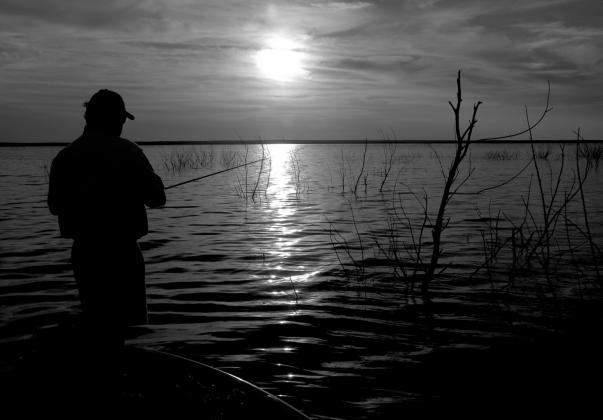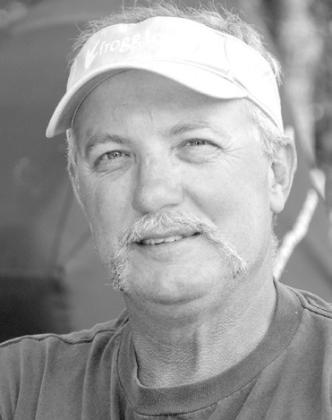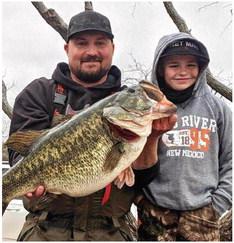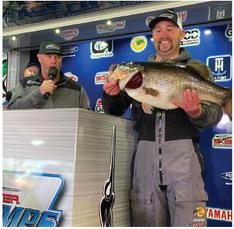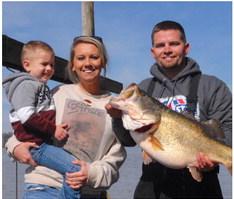It’s high time for a new state record largemouth, but where will it come from?
Texas’bass fishing community is hungry for a new state record to replace Barry St. Clair’s 18.18-pound mark set in January 1992.TPWD experts believe several reservoirs have the goods to produce one, but only time will tell when or if the stars line up for someone to make that lucky cast. (Photo by Matt Williams) The Great Outdoors by MATT WILLIAMS Outdoors Writer Brodey Davis’ 17.06-pound monster caught from O.H. Ivie last February currently ranks as the No. 7 heaviest Texas bass of all-time and the biggest fish reported in Texas since 1999. Released alive after a spawning stint at the Texas Freshwater Fisheries Center, the big fish was one fat crappie or gizzard shad shy of busting the state record. (TPWD Photo) Lake Fork isn’t producing the numbers of Texas giants it once did, but Tanner Spurgin’s 15.27 pounder in March 2021 is solid proof the 27,000-acre reservoir still has what it takes produce mega bass. (Bass Champs Photo) Joe Castle’s 15.34-pounder from Lake Nacogdoches in February 2020 is the biggest fish reported from the 2,200acre lake in 36 years. Genetics testing identified the 12-year-old bass as the offspring of a 14.50 pound Toyota ShareLunker caught in 2008 from Tyler State Park Lake.The fish was stocked in Lake Nacogdoches as an advanced growth (6.3 inch) fingerling later that year. Sadly, the big Nacogdoches bas was not released because it died due to stress complications at the ShareLunker headquarters. A second giant bass, unofficially weighed at 15-plus, was found floating dead at Nacogdoches two weeks after Castle’s fish was caught. (Photo by Matt Williams)
I don’t know what your holiday wish list looks like this year, but here’s hoping all you big bass buffs out there reel in a heavyweight too chubby for Santa to stuff in his fluffy red bag of goodies. Hopefully, somebody will get lucky and catch a new state record.
Super-sized largemouths are always females. Most will be nearing peak weight over the next month or so as the spawning season draws near.
Experts say a mature female bass with egg-swollen ovaries may weigh 10 percent more than it will without. Factor in a healthy breakfast and a big bass can develop a really serious weight problem in a hurry.
To wit: Brodey Smith’s 17.06 pounder caught from Lake O.H. Ivie last March was one fat crappie or big gizzard shad away busting the 18.18-pound state record. Barry St. Clair set the mark in January 1992. Smith’s fish is the No. 7 biggest Texas bass of all-time.
Texas’ bass fishing community is starving for a new record bass. It would be great for fishing and golden for Texas. Such a fish also would be fluffy feather in the cap of Texas Parks and Wildlife, especially if were confirmed as a direct offspring of a Toyota Legacy ShareLunker.
Legacy lunkers are Texas caught bass weighing 13-pounds or more that are loaned to TPWD for spawning and genetics research.
It won’t come as a surprise if someone strikes big bass gold at ‘Ivie in 2023. The West Texas lake has produced 34 Toyota ShareLunker entries over 13 pounds since January 2021, several in the mid-to-upper teens.
There were 73 double- digit fish documented in 2022 alone. Bassmaster Magazine ranked ‘Ivie the No. 1 bass lake in the Central United States and No. 2 in all of America.
Obviously, there is something special going on with the 32-year-old fishery that isn’t happening elsewhere. Just call it the perfect storm of factors including the new lake effect, great habitat, an abundant forage base and an army of Florida-strain bass that are simultaneously coming of age to reach trophy size.
Another key factor is the evolution of forward-facing sonar. The electronics technology gives savvy anglers the ability to sniff out big winter bass suspended over deep water, make precise bait presentations to them and see in real-time how the fish react to the lure.
’Ivie is a deep, clear lake that sets up perfectly for LiveScopers with its abundant salt cedars and hardwoods, some situated in 40 plus feet of water. Forward sonar helps anglers target suspended fish effectively that for years went unmolested. Most of the teeners caught there over the last two years were the result of casts that probably would have never been made before forward sonar.
O.H. Ivie is the odds-on favorite to produce Texas’ next state record bass, but it is hardly the only reservoir with the goods to get it done. To learn more, I asked for some input from Texas Parks and Wildlife Department fisheries biologists around the state. Here’s what they had to say: Craig Bonds TPWD Director of Inland Fisheries Bonds agreed that ‘Ivie is the frontrunner due in part to well-timed Florida bass and ShareLunker stockings that have coincided with successive water levels rises, but claims the next tier of lakes are wide open.
“It seems every Share-Lunker season brings new surprises, like Possum Kingdom last year,” he said. “The great thing about Texas is any lake can be included, especially those about a decade out from some significant hydrologic event, such as new-lake filling, partial or full recovery from low water levels, and combined with past stockings of bass containing genetic potential to reach maximum sizes.”
Robert Mauk TPWD District Supervisor, Wichita Falls Mauk ranks Possum Kingdom as the best bet under his watch. The 15,600acre reservoir produced three Legacy ShareLunkers the 13 pound range last year. “Though I would say it is probably a couple years away since the Legacy bass produced this year were all just over 13 pounds, PK has produced one fish over 16 pounds in the past. There no reason to think it can’t produce a bigger one in the future. Golden algae is the wildcard at PK that could alter the population in a heartbeat”.
Todd Driscoll TPWD District Supervisor, Brookeland Driscoll ranks 2,200 Lake Nacogdoches at the top of his hit list, followed by Sam Rayburn and Toledo Bend as the dark horses.
“Lake Nacogdoches has produced its share of 8-12 pound bass for years, in part due to the 16-inch maximum length limit, consistent quality habitat and annual Florida bass stockings,” he said. “Several recent catches of larger fish could make this lake part of the state record discussion in 2023. In 2020, a lake record 15.34-pound ShareLunker Legacy fish was caught, and just a few weeks later another 15-pounder was found dead. In 2022, an additional 13.27-pound ShareLunker was caught.
“Given the trophy production history of Sam Rayburn and Toledo Bend, you can’t ignore these reservoirs,” he added. “I believe a single catch of a state record fish is possible from either reservoir, due to the long history of annual Florida bass stockings, the seclusion provided by the large size of both reservoirs (potentially enabling trophy bass to reach maximum age/size), and now increased angling vulnerability of these fish with forward-facing sonar.”
Jake Norman TPWD District Supervisor, Tyler Lake Fork isn’t cranking out the number of teeners it once did, but Norman says there is way too much history there to leave it off the list.
“When you combine a excellent forage base, a trophy- oriented harvest regulation and quality offshore habitat, you can never write off a few giants swimming around,” Norman said. “The lake isn’t as conducive to chasing giants with forward sonar as some other water bodies, but folks are still figuring out how to utilize the technology on Fork. The lake produced a 15.27 in March of 2021, indicating she can still grow some giant bass.
“Honestly, I think the high angling pressure is a blessing and a curse for Fork’s probabilities of producing a new state record. Obviously, the fishing pressure has resulted in some of the most challenging-to-catch bass in the state, but more anglers on the water also suggests a greater chance of one of them crossing paths with the new Ethel. We had some strong year classes (spawns) in 2015 and 2016 after the lake recovered form a prolonged drought, and some of those fish will be pushing 10-plus soon, if not already. It will take a few more years to see what the fish from those year classes can truly grow to, but the “intangibles” needed to produce giants are there for them.”
Norman adds that Richland Chambers near Corsicana also has a shot.
“Richland Chambers has the primary factors needed to produce a new record — great forage, quality offshore habitat and a fertile watershed,” he said. “Plus, enough of the dark horse characteristics to actually produce trophy fish under the radar. The lake doesn’t receive enough attention or fishing pressure to significantly handicap angler catch rates. The only large draw back to a state record coming from Richland Chambers is the amount of unproductive water on the 41,000-acre reservoir. A significant portion of the reservoir is not exactly rich in eye-popping bass habitat, but I’ve seen enough impressive tournament weights over the past several years to tell me the waterbody is growing some healthy fish right now.
Lynn Wright TPWD District Supervisor, San Angelo
Wright didn’t mince words when asked to defend his top pick — O.H. Ivie. There’s plenty of proof in the puddin.’
Given its recent track record of producing trophy bass, combined with the national attention the reservoir has received over the past two years, there will be plenty of anglers making a run for a new state record in 2023,” he said. “There’s no shortage of trophy bass in the pipeline either. In 2022 alone there were 73 double-digit bass entered into the TPWD ShareLunker Program from O.H. Ivie, 19 upwards of 13 pounds. Water levels have dropped over 9 1/2 feet in the last two years, which may further concentrate bass as they’re forced to move out from highly protected shallows with flooded brush and into deeper areas potentially more accessible to anglers.
Tim Bister TPWD District Supervisor, Marshall
Bister said he believes the work TPWD has been doing to introduce “big fish” genetics through stocking efforts from the ShareLunker Program should increase this possibility of producing new state record.
“I think the next state record will come from a lake that has a track record of producing big bass, a history of Florida bass stocking and restrictive fish harvest regulations to increase the chance that fish can survive to larger sizes. The two lakes at the top of the list for me based on these criteria are Fork and Caddo. A third lake to add to the list, based on recent catches of big fish, is O. H. Ivie.”
Matt Williams is a freelance writer based in Nacogdoches. He can be reached by email, mattwillwrite4u@yahoo. com.


